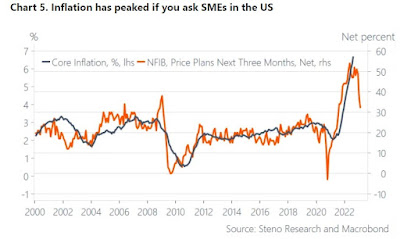*** denotes well-worth reading in full at source (even if excerpted extensively here)
Economic and Market Fare:Kelton: Inflation Hurts Everyone, But So Does Unemployment
Quotes of the Week:
1:
...If you accept the premise that margin expansion (trade services in the PPI) is a huge part of the inflation story, well… pic.twitter.com/N88FvksiZL
— Ian Shepherdson (@IanShepherdson) September 15, 2022
...Margin inflation falling:
— The Transcript (@TheTranscript_) September 15, 2022
[H/t @carlquintanilla] pic.twitter.com/9mn2L1Bqkx
...Core PPI “overstated by a technicality .. underlying trends improving rapidly .. a reminder that the #CPI numbers are not the only inflation data worth watching; the message from this report is that disinflation is underway. It has much further to go.” - @PantheonMacro pic.twitter.com/t4SXIjGCs3
— Carl Quintanilla (@carlquintanilla) September 14, 2022
History is very consistent - bond yields will not go down and stay down until the Fed is at their last rate hike. Then bonds rally hard. We remain neutral on LT bonds here. Trying to be patient. #macro #Fed #pivot $TLT pic.twitter.com/GBlKKN1ZSK
— Kantro (@MichaelKantro) September 10, 2022
(not just) for the ESG crowd:
GeoPolitical Fare:
Right, everyone. I need to be serious for a moment. Because the greatest thing that ever happened is happening right now.
— ❓🦎 (@curiousiguana) September 14, 2022
I don't particularly care either way about the Queen. But the queue? The Queue is a triumph of Britishness. It's incredible.
Contrarian Perspectives
Extra [i.e. Controversial] Fare:
*** denotes well-worth reading in full at source (even if excerpted extensively here)
Climate Fare:
...There is no energy transition; only addition of new energy sources like renewables.
— Art Berman (@aeberman12) September 14, 2022
There is no decline in fossil energy use, only a decrease in its percentage of total consumption.https://t.co/lAJZgP17WG#OOTT#fintwit#Commodities#energy #EnergyTransition #ClimateActionNow pic.twitter.com/pCd9SQFo6M
The real energy transition is a reduction
— Art Berman (@aeberman12) September 13, 2022
in energy use. This will never happen VOLUNTARILY.
Another slide from my talk last night at Houston Geological Society.
“Energy is the only truly universal currency.”
--Vaclav Smil pic.twitter.com/SKU1OFT3cH
Degrowth by disaster is now inevitable, and if we fail to plan for this catastrophic collapse, then we are planning to fail spectacularly. To ease the descent we must plan for, and seek, what socio-ecological justice we can. A #PlannedCollapse is a #JustCollapse. pic.twitter.com/mo8O9jEZXt
— Just Collapse (@JustCollapse) September 10, 2022
Endemic Fare:
Read everything by eugyppius; el gato malo; Mathew Crawford; Steve Kirsch; Jessica Rose!
Paul Alexander, Berenson, Chudov, Lyons-Weiler, Toby Rogers are also go-to mainstays; a list to which I have added Andreas Oehler, Joey Smalley (aka Metatron) and, Julius Ruechel; Denninger worth staying on top of too for his insights, and especially his colorful language; and Norman Fenton; Marc Girardot; plus Walter Chesnut (on twitter); new additions: Sheldon Yakiwchuk and Aaron Kheriarty; I will of course continue to post links to key Peter McCullough material, and Geert Vanden Bossche, and Robert Malone, and Martin Kulldorff, and Jay Bhattacharya, and Sucharit Bhakdi, and Pierre Kory, and Harvey Risch, and Michael Yeadon, and John Ioannidis, and Paul Marik, and Tess Lawrie, and Zelenko, and Dolores Cahill, and [local prof] Byram Bridle, and Ryan Cole, and…
Radagast: How to destabilize everything: An unprecedented experiment on the human holobiont
CO-VIDs of the Week:
Anecdotal Fare:
COVID Conspiracy Fare:
Back to Non-Pandemic Fare:
On Russian state TV, Moscow State University professor Vitaly Tretyakov said (and I'm paraphrasing): “The West thinks there will be social unrest in Russia in order to make the war stop. In reality, there will be social unrest if we don't become more active in this war.”
***** CaitOz Fare:
...... The trouble with “western values” is that westerners don’t value them. They think they value them, but all that reverence for free expression and holding power to account with the light of truth goes right out the window the second they see someone saying something that sharply differs from what their rulers and their propagandists have told them to think. Then they want that person silenced and shut down.
Welsh: Lazy V.S. Uninterested & Quiet Quitting












No comments:
Post a Comment